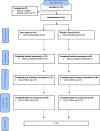Assessing the impact of the iPeer2Peer program for adolescents with juvenile idiopathic arthritis: a mixed-methods randomized controlled trial
- PMID: 39731098
- PMCID: PMC11674074
- DOI: 10.1186/s12969-024-01052-5
Assessing the impact of the iPeer2Peer program for adolescents with juvenile idiopathic arthritis: a mixed-methods randomized controlled trial
Abstract
Background: Juvenile Idiopathic Arthritis (JIA) is a chronic pediatric illness, whereby youth experience physical, emotional and psychosocial challenges that result in reduced health related quality of life (HRQL). Peer mentoring has been shown to improve disease self-management in adults with chronic conditions, with mixed results in younger populations. Building on our pilot work - which supported the feasibility and initial effectiveness of the iPeer2Peer program - the objective of this study was to assess the clinical effectiveness of the program in youth with JIA through a waitlist randomized controlled trial.
Methods: Eighty-one youth (aged 12-18) were randomized to the intervention group and matched with trained peer mentors (18-25 years; successfully managing their JIA), completing of up to ten 30-min video calls over a 15-week period. Eighty-three youth in the control group received standard care. Outcome assessments occurred at enrollment, 15 weeks post randomization and 6-months post randomization. The primary outcome was self-management, measured using the TRANSITION-Q. Secondary outcomes were HRQL, pain, emotional distress, disease knowledge, self-efficacy, and perceived social support. These were assessed using linear mixed effects models. Content analysis of semi-structured interviews and focus groups was used to assess satisfaction with the program with mentors and mentees upon study completion.
Results: In total, 164 youth (mean age 14.4 ± 1.9 years, 78% female) were randomized to the study. The proposed sample size was not reached due to challenges in recruitment, likely impacted by the COVID-19 pandemic. The iPeer2Peer program did not show significant improvement in self-management (p = 0.7), or any of the secondary outcomes. Three key categories emerged from content analysis: (1) Fulfillment and Support Through Shared Experience, (2) Enhancing Program Delivery and (3) Strategies to Boost Engagement. These findings highlight that mentees valued the ability to converse with mentors who empathized with their disease experience, while mentors found it fulfilling to support mentees, and noted that they could have benefited from this type of support themselves.
Conclusion: While the iPeer2Peer did not result insignificant changes in clinical outcomes, both mentors and mentees were satisfied with the program and felt that mentorship provided real-world benefits for disease management and overall wellbeing.
Trial registration: ClinicalTrials.gov, NCT03116763. Registered 31, March 2017, https://www.
Clinicaltrials: gov/study/NCT03116763.
Keywords: Adolescent; Juvenile idiopathic arthritis; Online; Peer support; Randomized control trial; Self-management.
© 2024. The Author(s).
Conflict of interest statement
Declarations. Ethics approval and consent to participate: Research ethics board approvals were obtained from SickKids (REB #1000054878), Children’s Hospital for Eastern Ontario (REB #17-77X), BC Children’s Hospital (REB #H17-00285), IWK Health Centre (REB #1022331), Alberta Children’s Hospital (REB #17-2098_REN3), and London Health Sciences (REB #112368). Consent for publication: Not applicable. Competing interests: The authors declare that they have no competing interests.
Figures
Similar articles
-
The iPeer2Peer Program: a pilot randomized controlled trial in adolescents with Juvenile Idiopathic Arthritis.Pediatr Rheumatol Online J. 2016 Sep 2;14(1):48. doi: 10.1186/s12969-016-0108-2. Pediatr Rheumatol Online J. 2016. PMID: 27590668 Free PMC article. Clinical Trial.
-
Teens Taking Charge: A Randomized Controlled Trial of a Web-Based Self-Management Program With Telephone Support for Adolescents With Juvenile Idiopathic Arthritis.J Med Internet Res. 2020 Jul 29;22(7):e16234. doi: 10.2196/16234. J Med Internet Res. 2020. PMID: 32723728 Free PMC article. Clinical Trial.
-
The iPeer2Peer mentorship program for adolescent thoracic transplant recipients: An implementation-effectiveness evaluation.J Heart Lung Transplant. 2025 Jun;44(6):858-871. doi: 10.1016/j.healun.2024.09.001. Epub 2024 Sep 12. J Heart Lung Transplant. 2025. PMID: 39260753
-
Impact of summer programmes on the outcomes of disadvantaged or 'at risk' young people: A systematic review.Campbell Syst Rev. 2024 Jun 13;20(2):e1406. doi: 10.1002/cl2.1406. eCollection 2024 Jun. Campbell Syst Rev. 2024. PMID: 38873396 Free PMC article. Review.
-
Understanding the essential components and experiences of youth with autism spectrum disorders in peer mentorship programmes during the transition to adulthood: A qualitative meta-ethnography.Child Care Health Dev. 2020 Nov;46(6):667-681. doi: 10.1111/cch.12804. Epub 2020 Sep 3. Child Care Health Dev. 2020. PMID: 32840907 Review.
Cited by
-
What have we learned from long-term studies in juvenile idiopathic arthritis? - Prediction, classification, transition.Pediatr Rheumatol Online J. 2025 Feb 19;23(1):18. doi: 10.1186/s12969-025-01070-x. Pediatr Rheumatol Online J. 2025. PMID: 39972461 Free PMC article. Review.
References
-
- Sacks JJ, Helmick CG, Luo Y, Ilowite NT, Bowyer S. Prevalence of and annual ambulatory health care visits for pediatric arthritis and other rheumatologic conditions in the United States in 2001–2004. Arthritis Rheum. 2007;57(8):1439–45. - PubMed
-
- Schanberg LE, Gil KM, Anthony KK, Yow E, Rochon J. Pain, stiffness, and fatigue in juvenile polyarticular arthritis: contemporaneous stressful events and mood as predictors. Arthritis Rheum. 2005;52(4):1196–204. - PubMed
-
- Reiter-Purtill J. A controlled longitudinal study of the social functioning of children with juvenile rheumatoid arthritis. J Pediatr Psychol. 2003;28(1):17–28. - PubMed
Publication types
MeSH terms
Associated data
LinkOut - more resources
Full Text Sources
Medical



